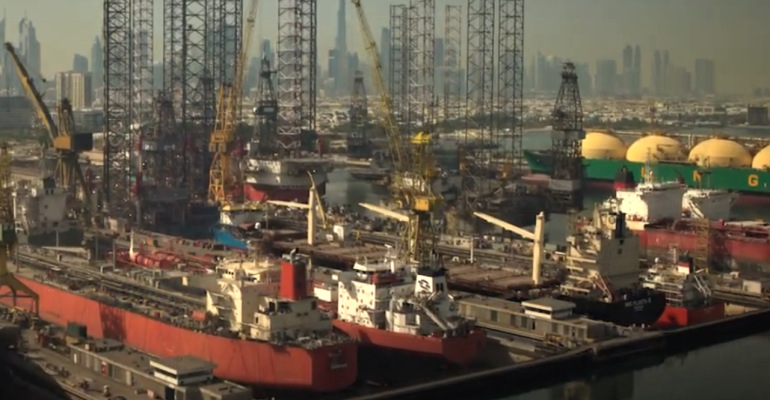Ship repair and maintenance businesses have traditionally lagged in new technology deployment. However, the prism through which we view and solve the challenges of these complex physical assets needs updating, writes Peter Jackson, vice president, Business Transformation Solutions at Drydocks World.
Peter Jackson | Jul 18, 2024
Aging fleets, rising demand for maintenance and conversion, as well as expanding offshore oil, gas and renewable projects are driving the growth of the global ship repair and maintenance services market. But for the industry to reach its projected market size of $53.23 billion by 2032, digital transformation must play a central role.
Ship repair and maintenance businesses play a crucial role in maintaining the efficiency, functions and safety of a wide range of global maritime fleets. However, modern vessels’ complex requirements, supply chain and logistics disruptions, as well as regulatory compliance for international standards and environmental regulations all require efficient and innovative solutions.
Related: Drydocks World upgrades propeller repair facilities
Factoring in the speed and demand for vessels post-pandemic, ship repair facilities need to be efficient and cost effective. That is no mean feat in an industry dominated by physical assets.
Ship repair and maintenance businesses have traditionally lagged in new technology deployment. However, the prism through which we view and solve the challenges of these complex physical assets needs updating.
Related: Cosco Shipping Heavy Industry expanding Zhoushan ship repair capacity
The revolution in ship building requires more than automating processes, which is not an all-encompassing solution in an industry where tailored solutions are required. There is a clear need for digital technologies to enhance our industry and create the efficiencies that satisfy global demand.
Smart digital systems are needed to boost productivity, collaboration and planning. 5G-enabled technologies like machine learning, virtual and augmented reality, and AI will open up enhanced analysis and efficiency in shipyards, as well as scalable, modular shipbuilding.
Our business transformation journey at Drydocks World started in 2018 with the development of a new Strategic Master Business Plan, tailored to guide our evolution. In 2023, we further refined our strategy by creating a revised 10-year Master Business Action Plan, which places business transformation as one of our six key strategic pillars of growth.
While we continue our ship and rig repair operations, we are also expanding our capabilities to handle more large-scale conversion projects, as well as moving into engineering, procurement, and construction (EPC), to integrate into the wider value chain beyond our traditional maritime construction focus. By doing so, we have entered areas in which oil, gas and renewable clients have significantly different expectations regarding digital integration compared to typical ship repair yards.
The drive to support the growth of our industry has led us to a digital transformation journey that I believe brings us closer to our customers and gives us the operational efficiencies to make us the best production business in the maritime industry. By the end of this year, we will have implemented 70% of the digital transformation projects we set out to achieve three years ago, not only in frontline activities but in our wide range of supporting departments.
The foundations began with the transformation of our IT infrastructure with over 100 servers that were previously on-premises now 90% in the Azure cloud platform. This transition allows seamless connectivity from any approved device, facilitating real-time access to data and enhancing collaboration.
We now utilise Oracle Fusion as our back-office ERP system and will go live with our production ERP this year. Our Purchase Requisition to Purchase Order process is now entirely digital and provides clarity to our wide range of suppliers, who are informed at each stage of the procurement process. Meanwhile, our “PowerApps” initiative is saving time and resources by allowing subcontractors to interact with us digitally, so that we can efficiently allocate skilled resources among our thousands of daily contractors.
Drydocks World has moved away from paper-based processes to digital solutions, such as our 2D berth planning solution built on a digital twin. This is evolving to a 3D version, enabling us to track mobile plant forklifts around the yard using IoT devices, developed in collaboration with Zodiac, DP World’s in-house IoT business unit. We are also exploring AI and machine learning applications to improve business value and efficiencies, such as streamlining recruitment, onboarding, and retention processes in the People department.
And we are enhancing business connectivity with our ‘Drydocks World Tech-Aid’ platform, a centralised resource for technology insights, industry trends, best practices, and organisational tech integration. The platform features regular tech-tip updates and includes a ChatGPT Tool for immediate IT and technology support. All of these transformations are informing our business intelligence journey, building a data warehouse and data lake to better analyse and utilise information.
In a fragmented and challenging global landscape, evolving heavy manufacturing and engineering industries is no longer optional. Economic growth, employment and the energy transition depend on our evolution. I believe our own journey demonstrates that there is a way forward for businesses that have relied on traditional solutions in a physical asset industry like ship repair and maintenance. However, as our own business transformation has shown, these goals can’t be achieved without a holistic perspective. The time to act is now.

